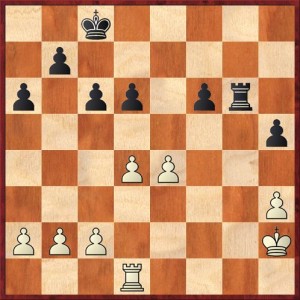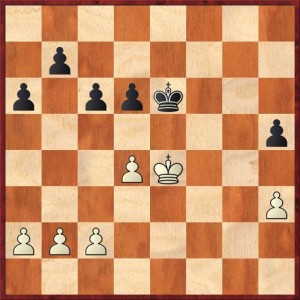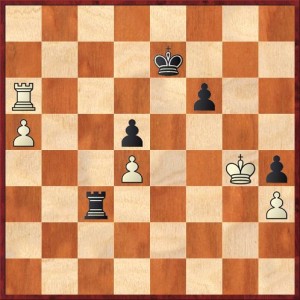When I played my first game against a world champion (the world computer champion, Belle, in 1983), I knew that I was playing a world champion. That was not the case the second time.
On the weekend after New Year’s Day in 1988, I decided to play in one of Bill Goichberg’s big tournaments, the Continental Open, to start the year. I was living in North Carolina at the time and the tournament was in Rye, New York, so it was a pretty long trip. But I was on the cusp of making my first National Master rating (2200), and I had just won my second state championship. I was feeling very confident in my chess and thought that I had a good shot at a prize in the Under-2200 section.
In fact I tied for second, with a 4½-1½ score, and I did reach my goal of 2200. So it was a great tournament for me.
The one person who finished ahead of me, at 5½-½, was an UNRATED player named Gustavo Hernandez. Right away, when you are playing at a Bill Goichberg tournament and you see an unrated player from a foreign country winning game after game in the under-2200 section, you think, “Ringer.” It’s a problem Goichberg has faced throughout the years, because he organizes the biggest money tournaments in the U.S., and they are a magnet for sandbaggers and foreign players with no USCF rating. Goichberg does his best to figure out the true strength of these people, but he doesn’t always succeed.
So going into this game, I knew I was facing a strong player but I didn’t know how strong. I heard after the tournament that he was the champion of the Dominican Republic. But nobody told me — probably nobody knew — that he was in fact the world under-18 champion! I didn’t find out until 23 years later — last year, in fact — when I just happened to read the Wikipedia article on the World Youth Chess Championship. At the very top of the list of winners of the under-18 title, the winner of the first tournament in 1987, was … Gustavo Hernandez of the Dominican Republic!
In future years, the winners of this title would include a virtual Hall of Fame of chess talent: Vladimir Kramnik, Shakhriyar Mamedyarov, Ruslan Ponomariov, … I’m still very proud of earning a draw against a player on such a list. (Hernandez, by the way, is still active in FIDE chess and is an International Master.)
The opening and middlegame of this game are not too interesting, but the endgame is very interesting indeed. Hernandez felt after the game that he must have missed a win somewhere. I didn’t think so. I was especially proud of my move 35. … b4, a pawn sac that allowed me to activate my rook.
Twenty-four years later, Rybka reveals the truth … but you don’t want me to give it away so easily, do you? For readers who want an analytical challenge, play through the game in the PGN viewer below. I have deliberately not made any comments after move 23. You have two questions to answer:
- Was Hernandez right? Did White miss a win?
- Was my move 35. … b4 a game-saver or a blunder?
For the rest of you who prefer slightly easier challenges, I’ll talk about a couple other critical positions in the game before I go on to these questions.
FEN: 2k5/1p6/p1pp1pr1/7p/3PP3/7P/PPP4K/3R4 w – – 0 25
Here Hernandez played what I thought at the time and still think was a real master move: 25. Rd3! Rybka is not so impressed, and considers it just one of many moves that lead to approximate equality.
This is one case where I think the computer analysis is misleading. I’m sure that Hernandez looked first at the king-and-pawn endgame after 25. Rg1 Rxg1 26. Kxg1 Kd7 27. Kf2 Ke6 28. Ke3 f5 29. Kf4 fe 30. Kxe4 (diagram)
FEN: 8/1p6/p1ppk3/7p/3PK3/7P/PPP5/8 b – – 0 30
Win for White or draw? This one is right on the borderline. The idea for Black is to play 30. … Kf6 31. Kf4 a5! Note that Black can never win the battle for the opposition, because White has a free move (h4) and Black doesn’t (… h4 loses a pawn). Nevertheless, White cannot break through unless he dislodges the pawn at d6. In order to do this, White has to play for the break c4-c5. Black’s defense is to play … a5 and … b6 and exchange as many pawns as possible. Rybka says that this idea is just good enough to draw, although Black has to find a couple of only moves. I’ll leave it to you (or your computer) to figure out the remaining details.
Hernandez’s 25. Rd3 showed great judgement. He obviously couldn’t work the K+P endgame out to a clear win, and there’s an old saying that you don’t want to enter a K+P endgame unless you’re absolutely sure it wins. The point of 25. Rd3! is that White would like to enter the same K+P endgame a tempo ahead, after 25. … Kd7 26. Rg3 Rxg3 27. Kxg3. Now he would be completely winning!
Of course Black doesn’t have to allow this. The simplest solution, as Rybka points out, is just to play 25. … Rg7 with the idea of answering 26. Rg3 with 26. … Re7 pressuring the e5 pawn. I can’t argue with that. So technically, Rybka is right. White’s subtlety with 25. Rd3 made no difference if Black defended perfectly.
However, humans aren’t perfect! I was afraid of 26. Rg3 and played 26. … h4?! This isn’t the losing move but it is an inaccuracy, because the pawn on h4 is an easier target than it was before.
Now let me get to those questions I started out with. I’ll answer the second one first.
FEN: 8/8/p4p2/Pp1p1k1r/3P2Rp/2P2K1P/1P6/8 b – – 0 34
Up to this point White has played extremely well. His move 34. c3! has created a zugzwang, where Black has to retreat with either his rook or his king. I played 34. … Rh7 and Hernandez played 35. Rg8. And now I played the surprising 35. … b4, with the idea that after 36. cb? Rb7, essentially all five of White’s pawns are islands. None of them can defend the others.
However, Hernandez continued to play perfectly for several more moves and achieved a winning position. So we have to conclude that 35. … b4 was a blunder, even though it looked great at the time. Rybka says that Black must first safeguard the d-pawn with 35. … Rd7! and only after a move like 36. Rh8 play 36. … b4! If White tries to stop … b4 altogether with 36. Rb8, Black seizes the g-file with 36. … Rg7! and sinks the rook into g3, with enough counterplay to save the game.
In other words, I had the right idea but the wrong execution. Chess is pretty darned subtle sometimes. When you see a great shot like … b4 it’s very hard to hold back from playing it.
Hernandez capitalized on my error in exactly the right way, according to Rybka: after 35. … b4? he played 36. Rd8! (hitting the d-pawn) bc 37. bc Ke6 38. Kg4 Rc7 39. Ra8 Rxc3 40. Rxa6+ Ke7 41. Ra7+ Ke6 42. Ra6+ (obviously played to gain time on the clock) 42. … Ke7 and now we reach the position where White makes his only blunder of the game.
FEN: 8/4k3/R4p2/P2p4/3P2Kp/2r4P/8/8 w – – 0 43
I’ve said before that one reason chess is so much harder than it appears to be in books is that when you’re playing a game, you never have someone to tap you on the shoulder and say, “White to play and win.” That gives you two big clues: First, White should be looking for a win. (Well, that is obvious here, but sometimes it isn’t.) Second, the fact that it’s a puzzle in a book means the obvious move probably isn’t the right move.
In the game Hernandez played what seemed like a completely natural move: 43. Kxh4? I doubt that he even took very long thinking about it. This is exactly where he needed someone to tap him on the shoulder and say, “Think about it.”
What’s wrong with 43. Kxh4? The answer is that it gives Black enough time to win the d-pawn. With 43. Ra8! the a-pawn gets moving one tempo quicker and Black does not have time both to win the d-pawn and to get his king to the “safe haven” of g7 and h7. After 43. … Rd3 44. a6 Rxd4+ 45. Kf5 Ra4 46. a7 Kf7 and White wins with the oldest trick in the book: the X-ray check 47. Rh8! Rxa7 48. Rh7+. Black was one tempo short of a draw.
But after the tempo-losing 43. Kxh4? Black does have time both to corral the d-pawn and to stop the a-pawn. The game concluded 43. … Rd3 44. Rb6 (some kibitzers criticized this after the game, but there was nothing better) Rxd4+ 45. Kh5 Ra4 46. a6 d4 47. Kg4 d3+ (my second discovered check with a pawn in one game!) 48. Kf3 Rd4! 49. a7 d2 50. Rb1 Ra4 51. Rb7+ Ke6 52. Ke2 Ra2 53. h4 f5 ½-½. With the threat of … f4-f3+ looming, White has to give up his a-pawn to win the d-pawn, and the game is then a complete draw.
I think that the position on White’s 43rd move is a beautiful case study to illustrate the fact that TEMPI are more important than MATERIAL in rook endgames. It’s ironic that White’s excellent 25th move showed his awareness of the value of a tempo, but he forgot to be aware of it later.
Also, this game shows that you can’t see what you don’t look for. An IM-level player should be able to spot the winning idea with Ra8 and the X-ray check — it’s a familiar pattern that is in every endgame book. I think that Hernandez just took the h-pawn automatically and forgot to look for something better.
Hope you enjoyed this game!







{ 1 comment… read it below or add one }
Nice game, and very insightful comments – thanks.